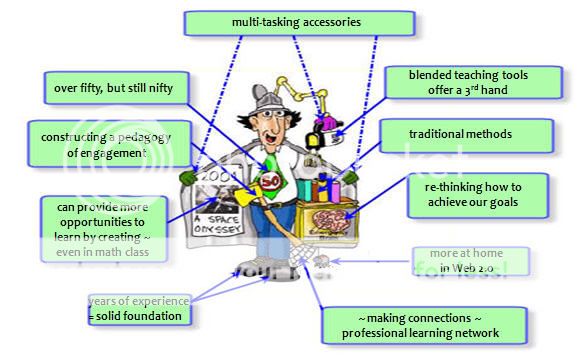When Shaun stomped in through the Learning Centre doors over two years ago, the first thing I noticed about him was his hair. It was a blue Mohawk carefully gelled into a series of 6 nearly foot-long spikes. He wore DM's that bucked up his calves and his jean jacket was embellished with hand-drawn gang and drug symbols. Everything about Shaun’s demeanor said: “I'm dangerous; you don't want to take me on.” But we did and thanks to the great work of a crew of teachers who could see through the outer armour to the funny and creative person inside, Shaun began trust school again and gradually let his guard down. This time last year he was the school’s Santa at the annual Christmas dinner. Now he's one course away from graduating and going to college in January. What's left? Math.
Shaun sees himself as terrible in math and like a little kid faced with a plate of food on which there’s one thing that he hates to eat -- he's left it to the very last. Now he's angrily pushing it around the plate, hoping that I (his math teacher) will let him get away without having to finish it. We've had a positive working relationship until now, but it's rapidly souring. Shaun has enrolled in a college program that starts in January, and every day the pressure to do what seems impossible -- finish math -- increases.
The lessons of my cognition course (of which this is the last week) say to recruit a student’s emotions into the service of learning, but Shaun's emotional triggers are so overwhelming that just sitting in math class floods him with feelings that he's stupid for even thinking he could do this and that the only smart response is to run. To Shaun’s credit, his goal of graduating is so strong that he hasn’t given up, but there’s so little time left before his new college program starts in January that the pressure on us both is becoming unbearable.
The only way I’m going to be able help Shaun if I can get him to turn this last educational threat into a personal challenge. He’s sealed off any connection to former math learning by deciding that his previous success in the last math course was a fluke. If I can use a little neuroscience to help him understand what's going on, I might be able to finally help this wonderful young man conquer this last and worst monster. It’s with that in mind that I’m writing this letter to Shaun. [Note: Shaun is an accomplished actor; hence the ‘thespian’ references.]
Dear Shaun:
I’ve been thinking hard about you and your math. In fact I’ve been taking a course about the brain and how it learns, and everything that I've learned says that the old skills that have been haunting you for so long can be mastered if: (a) you understand a little about what you're up against, (b) you stop trying to overcome your anxiety with deafening music because it’s blocking all the learning at the same time, and (c) I can create learning activities that will draw on all your strengths as an actor.
Your mum says that these problems in math go way back to about grade 2 or 3 when you had 2 inflexible teachers in a row. Since then you think you’ve had year after year of bad experiences in math. You probably even think that there’s some missing or malfunctioning region in your brain without which a guy can’t do math. But, Shaun, I had a look at all your old report cards yesterday. Your success in math has been uneven, but not nonexistent. It took a big dive in grade 6, but that’s not unusual. Many students I work with report that their serious problems in math go back to about grade 5 or 6 because that’s when kids generally begin to give up. What’s different about you is not that you’re feeling anxiety, but the way it’s been amplified to a brain-numbing level. The brain scientists say that 2 things will throw your brain offline: stress and trying to multitask. The nerve cells in your brain don’t fire properly if you’re under stress. The brain regions that need to function together like a symphony orchestra to turn experiences into learning can’t do that if you’re inputting competing messages at the same time.
There’s no black hole of math in your brain, Shaun. The process of learning math is handled by a collection of brain regions all acting together like a troupe of actors. They have to work as a collective under the leadership of a director who believes they can create a living experience out of lines in a script and props on a stage. Although the brain doesn’t find it easy to learn math, there are many natural talents it does have which can help -- the ability to find patterns, make predictions, and learn from experience, to estimate, problem solve, and think creatively -- these are all innate strengths that make math learning possible -- yes, Shaun, even for you. Finally you can grow your own brain -- not make it larger -- but create new neural pathways inside it which is how memories are stored.
We Learning Centre teachers did you a disservice, Shaun, by not insisting that you do your Math 11 right after you finished Math 10. All the neural pathways that developed and strengthened as you did that course are way harder to access now because we let so much time pass. The skills and memories you gained in Math 10 were real; they resided in real brain networks that we could have seen lighting inside your brain up if we’d hooked you up to a brain imaging MRI machine. The fact that we neglected them for so long is making your learning harder now than it needed to be, and for that I’m sorry. But it’s still possible to reactivate old neural networks and to grow new ones whenever you need them. In fact, every time you learn a new script, Shaun, that’s exactly what your brain is doing. If you can reframe the task of learning math that way and think of it as a script for a play you finally have to learn well enough so you can perform for a few weeks in order to get to closing night -- graduation -- then I can help you reach that goal.
I’m going to shift the metaphor for a moment, Shaun. I’m envisioning you now as the captain of naval ship in an old WWII movie. As I see it, you’re letting your emotions steer your boat when they should be the navigation system. They should be guiding you through the mine field of choices about which methods do and don't work when you're tackling a question, but all they're doing is shouting from the bridge: “Danger! Warning!” You're body is rightly responding by wanting to run away. It’s under the control of an ancient part of your brain that will always act to protect you when faced by a threat. The problem is that the warning system isn't serving you well any longer. It’s still running the old math/threat software, even though math is now your ticket to graduating and going on to college. Your ancient brain is now preventing you from doing what you need to do to get something you really want. The good news is that the modern part of your brain still wants to make meaning out of math for you, Shaun, but the conscious you must reclaim the role of steersman (if you’re thinking about the boat image) or director (if the play comparison is the one you like better) because you can’t trust your instincts to guide you safely to your goal.
I sometimes ask why certain students end up with me in math and it usually comes down to a life lesson that they need to come to grips with before they can let the old image of themselves as a “poor students” go and claim their new lives after high school. I think, Shaun, that your K-12 education will not be truly complete until you find a way to manage your emotions by deliberately morphing threats into challenges when the learning gets tough. Interestingly, the body experiences the same physical responses either way, but you can train your brain not to always leap from those physical cues to the conclusion that you’re in danger. I’m guessing that you have many of the same body responses when you’re on stage, but you don't try to escape or take nights off during the run. You probably even say that heightened emotions give you a mental sharpness that's helpful ……. and that's where we need to go with this math challenge.
There are 3 executive functions in your brain that are going to enable you to make this Shaun-directed transformation of seeing math as a challenge like you see being in a play as a challenge. The first is called “inhibitory control.” It helps us make better choices in difficult circumstances. The second is “working memory.” You use this one when you learn a big script and hold all of it in your mind. The last one is known as “cognitive flexibility. This is how we switch our point of view or how we’re thinking about something.
So, over the next few weeks, Shaun, we're going start steering your brain to think of your time in math class like being in rehearsal. It will be as if you’ve decided to accept a script that you turned down over and over before because it didn't have any value for you. Now they've upped the offer so you've decided to take it on. You’re going to have to bring all of those 3 high level, modern brain functions -- inhibitory control, working memory, and cognitive flexibility -- to bear on the work of learning this script -- i.e on shifting math out of the threat category into the “can do” range.
Shaun, math will probably never be your favourite thing, but your anxiety about it should not govern your choices about what you will not do for the rest of your life. You have a long and wonderful future ahead. You don’t want this old clunky, junky program to always deter you from making certain career choices or from helping your own son with his homework when he comes home unhappy and upset because the got stumped by a math question. You want to be the dad who tells the story about how he finally made peace with math and in doing so learned once and for all that he was capable of facing life’s most difficult challenges and coming away unscathed.
We have some work ahead of us, Shaun. Let's get started.
Your teacher,
Sue


























 Wilkes University
Wilkes University



